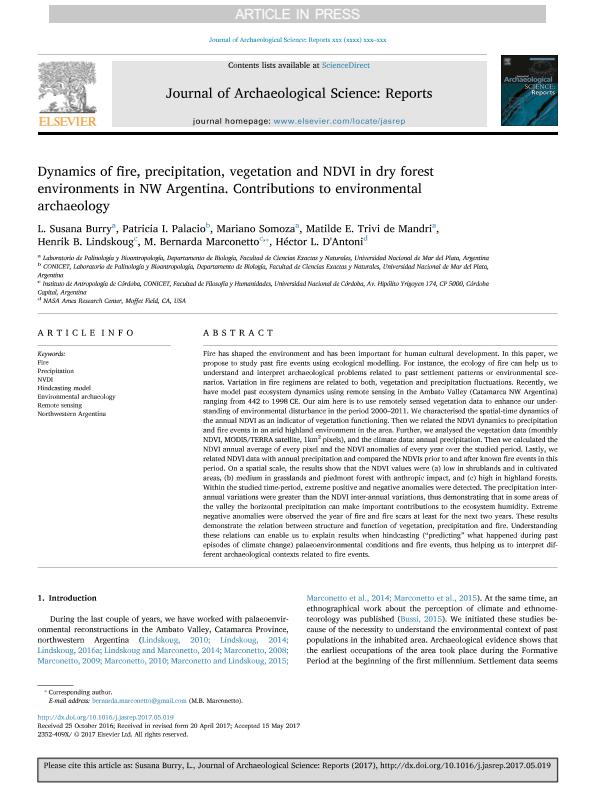Mostrar el registro sencillo del ítem
dc.contributor.author
Burry, Lidia Susana

dc.contributor.author
Palacio, Patricia Irene

dc.contributor.author
Somoza, Mariano
dc.contributor.author
Trivi de Mandri, Matilde E.
dc.contributor.author
Lindskoug, Henrik Bernhard

dc.contributor.author
Marconetto, María Bernarda

dc.contributor.author
D'Antoni, Héctor L.
dc.date.available
2018-10-24T18:26:38Z
dc.date.issued
2018-04
dc.identifier.citation
Burry, Lidia Susana; Palacio, Patricia Irene; Somoza, Mariano; Trivi de Mandri, Matilde E.; Lindskoug, Henrik Bernhard; et al.; Dynamics of fire, precipitation, vegetation and NDVI in dry forest environments in NW Argentina. Contributions to environmental archaeology; Elsevier; Journal of Archaeological Science: Reports; 18; 4-2018; 747-757
dc.identifier.issn
0305-4403
dc.identifier.uri
http://hdl.handle.net/11336/63000
dc.description.abstract
Fire has shaped the environment and has been important for human cultural development. In this paper, we propose to study past fire events using ecological modelling. For instance, the ecology of fire can help us to understand and interpret archaeological problems related to past settlement patterns or environmental scenarios. Variation in fire regimens are related to both, vegetation and precipitation fluctuations. Recently, we have model past ecosystem dynamics using remote sensing in the Ambato Valley (Catamarca NW Argentina) ranging from 442 to 1998 CE. Our aim here is to use remotely sensed vegetation data to enhance our understanding of environmental disturbance in the period 2000–2011. We characterised the spatial-time dynamics of the annual NDVI as an indicator of vegetation functioning. Then we related the NDVI dynamics to precipitation and fire events in an arid highland environment in the area. Further, we analysed the vegetation data (monthly NDVI, MODIS/TERRA satellite, 1km2 pixels), and the climate data: annual precipitation. Then we calculated the NDVI annual average of every pixel and the NDVI anomalies of every year over the studied period. Lastly, we related NDVI data with annual precipitation and compared the NDVIs prior to and after known fire events in this period. On a spatial scale, the results show that the NDVI values were (a) low in shrublands and in cultivated areas, (b) medium in grasslands and piedmont forest with anthropic impact, and (c) high in highland forests. Within the studied time-period, extreme positive and negative anomalies were detected. The precipitation inter-annual variations were greater than the NDVI inter-annual variations, thus demonstrating that in some areas of the valley the horizontal precipitation can make important contributions to the ecosystem humidity. Extreme negative anomalies were observed the year of fire and fire scars at least for the next two years. These results demonstrate the relation between structure and function of vegetation, precipitation and fire. Understanding these relations can enable us to explain results when hindcasting (“predicting” what happened during past episodes of climate change) palaeoenvironmental conditions and fire events, thus helping us to interpret different archaeological contexts related to fire events.
dc.format
application/pdf
dc.language.iso
eng
dc.publisher
Elsevier

dc.rights
info:eu-repo/semantics/openAccess
dc.rights.uri
https://creativecommons.org/licenses/by-nc-sa/2.5/ar/
dc.subject
Environmental Archaeology
dc.subject
Fire
dc.subject
Hindcasting Model
dc.subject
Northwestern Argentina
dc.subject
Nvdi
dc.subject
Precipitation
dc.subject
Remote Sensing
dc.subject.classification
Historia

dc.subject.classification
Historia y Arqueología

dc.subject.classification
HUMANIDADES

dc.title
Dynamics of fire, precipitation, vegetation and NDVI in dry forest environments in NW Argentina. Contributions to environmental archaeology
dc.type
info:eu-repo/semantics/article
dc.type
info:ar-repo/semantics/artículo
dc.type
info:eu-repo/semantics/publishedVersion
dc.date.updated
2018-10-19T15:28:19Z
dc.journal.volume
18
dc.journal.pagination
747-757
dc.journal.pais
Países Bajos

dc.journal.ciudad
Amsterdam
dc.description.fil
Fil: Burry, Lidia Susana. Universidad Nacional de Mar del Plata. Facultad de Ciencias Exactas y Naturales. Departamento de Biología. Laboratorio de Palinología y Bioantropología; Argentina
dc.description.fil
Fil: Palacio, Patricia Irene. Universidad Nacional de Mar del Plata. Facultad de Ciencias Exactas y Naturales. Departamento de Biología. Laboratorio de Palinología y Bioantropología; Argentina. Consejo Nacional de Investigaciones Científicas y Técnicas; Argentina
dc.description.fil
Fil: Somoza, Mariano. Universidad Nacional de Mar del Plata. Facultad de Ciencias Exactas y Naturales. Departamento de Biología. Laboratorio de Palinología y Bioantropología; Argentina
dc.description.fil
Fil: Trivi de Mandri, Matilde E.. Universidad Nacional de Mar del Plata. Facultad de Ciencias Exactas y Naturales. Departamento de Biología. Laboratorio de Palinología y Bioantropología; Argentina
dc.description.fil
Fil: Lindskoug, Henrik Bernhard. Consejo Nacional de Investigaciones Científicas y Técnicas. Centro Científico Tecnológico Conicet - Córdoba. Instituto de Antropología de Córdoba. Universidad Nacional de Córdoba. Facultad de Filosofía y Humanidades. Instituto de Antropología de Córdoba; Argentina
dc.description.fil
Fil: Marconetto, María Bernarda. Consejo Nacional de Investigaciones Científicas y Técnicas. Centro Científico Tecnológico Conicet - Córdoba. Instituto de Antropología de Córdoba. Universidad Nacional de Córdoba. Facultad de Filosofía y Humanidades. Instituto de Antropología de Córdoba; Argentina
dc.description.fil
Fil: D'Antoni, Héctor L.. National Aeronautics and Space Administration; Estados Unidos
dc.journal.title
Journal of Archaeological Science: Reports
dc.relation.alternativeid
info:eu-repo/semantics/altIdentifier/url/https://www.sciencedirect.com/science/article/pii/S2352409X16306216
dc.relation.alternativeid
info:eu-repo/semantics/altIdentifier/doi/http://dx.doi.org/10.1016/j.jasrep.2017.05.019
Archivos asociados
